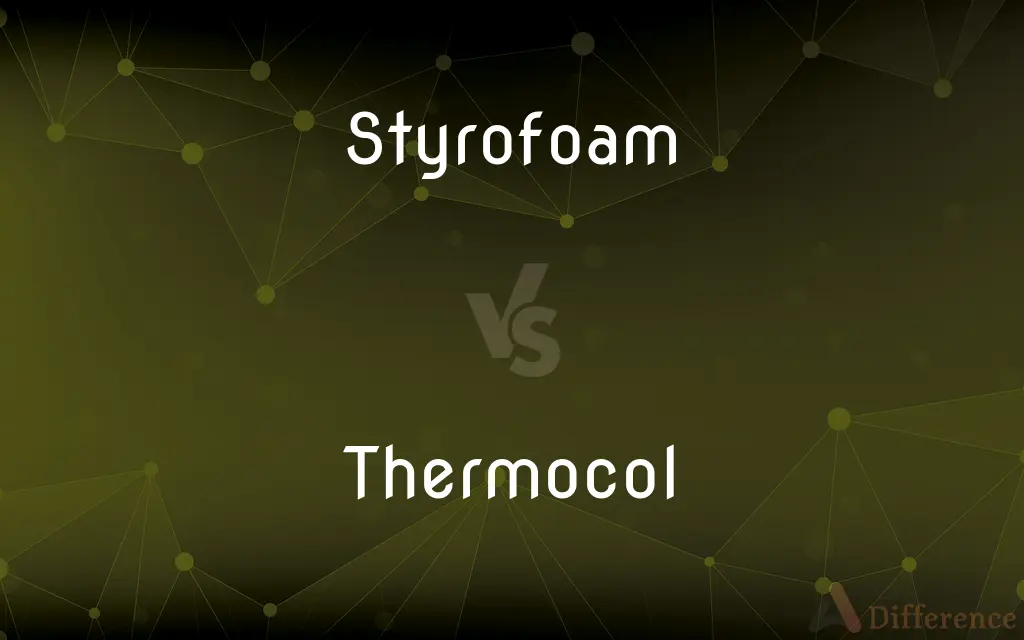Styrofoam vs. Thermocol — What's the Difference?
By Tayyaba Rehman — Published on January 1, 2024
Styrofoam is a brand name for extruded polystyrene foam, mainly used in building insulation, while Thermocol generally refers to expanded polystyrene foam, used in packaging and crafts.

Difference Between Styrofoam and Thermocol
Table of Contents
ADVERTISEMENT
Key Differences
Styrofoam is a trademarked brand name owned by The Dow Chemical Company for its blue extruded polystyrene foam (XPS), primarily used in building insulation and construction projects. Thermocol, often a colloquial term, generally refers to expanded polystyrene foam (EPS), a lightweight material used in packaging, disposable containers, and art and craft applications.
Styrofoam's structure is more rigid, dense, and moisture-resistant, making it suitable for insulation purposes. In contrast, Thermocol is less dense, has a more airy structure, and is widely used for its cushioning and insulating properties in packaging.
The manufacturing process of Styrofoam involves the extrusion of polystyrene, while Thermocol is made by expanding polystyrene beads, resulting in a different cellular structure and physical properties.
In terms of environmental impact, both Styrofoam and Thermocol pose challenges in disposal and recycling due to being polystyrene-based products. However, their lightweight and insulating properties make them popular in their respective applications.
While the term Styrofoam is often used interchangeably with polystyrene foam products, it technically refers to a specific type of XPS. Thermocol, commonly used in India and other regions, usually indicates EPS products.
ADVERTISEMENT
Comparison Chart
Material Type
Extruded Polystyrene Foam (XPS).
Expanded Polystyrene Foam (EPS).
Primary Use
Building insulation, construction.
Packaging, disposable containers, crafts.
Structure
Rigid, dense, moisture-resistant.
Less dense, airy, good cushioning.
Manufacturing Process
Extruded polystyrene.
Expanded polystyrene beads.
Environmental Impact
Challenges in disposal and recycling.
Similar challenges in disposal and recycling.
Compare with Definitions
Styrofoam
Trademarked by The Dow Chemical Company.
Styrofoam is a trademarked term, specifically referring to Dow's insulation products.
Thermocol
It is made by expanding polystyrene beads.
Thermocol sheets are created from expanded polystyrene for cushioning products.
Styrofoam
It is known for its rigid structure and durability.
Styrofoam panels are widely used due to their long-lasting properties.
Thermocol
Used for packaging, disposable containers, and crafts.
The Thermocol box ensured the food stayed warm.
Styrofoam
Commonly used in the construction industry.
Styrofoam is a popular choice for thermal insulation in buildings.
Thermocol
Popular in India and other regions for its insulating properties.
Thermocol is commonly used in Indian weddings for decorative purposes.
Styrofoam
Styrofoam is resistant to moisture and decay.
The basement was insulated with Styrofoam to prevent moisture buildup.
Thermocol
Thermocol generally refers to lightweight expanded polystyrene foam.
We packed the fragile items in Thermocol to prevent damage during shipping.
Styrofoam
Styrofoam is a brand of extruded polystyrene foam used for insulation.
We used Styrofoam for insulating the walls during construction.
Thermocol
Less dense and airy compared to extruded polystyrene.
Thermocol is often used for making lightweight models and crafts.
Styrofoam
Expanded polystyrene foam, such as is used in cups and packaging.
Thermocol
(India) polystyrene
Styrofoam
A light resilient foam of polystyrene
Common Curiosities
What is Styrofoam primarily used for?
Styrofoam is mainly used for building insulation and construction projects.
What are the common uses of Thermocol?
Thermocol is commonly used in packaging, disposable containers, and arts and crafts.
Is Styrofoam the same as general polystyrene foam?
No, Styrofoam is a specific type of extruded polystyrene foam and a trademarked brand.
Can Styrofoam be recycled?
Styrofoam recycling is challenging and not widely available, but it is possible.
How is Thermocol typically disposed of?
Thermocol disposal is often in landfills, as recycling options are limited.
Can Thermocol be used in construction?
While less common, Thermocol can be used for lightweight construction and decoration.
Can Thermocol be used for insulation?
Yes, Thermocol has insulating properties and is used for thermal insulation in packaging.
Are Styrofoam and Thermocol environmentally friendly?
Both pose environmental challenges due to difficulties in disposal and recycling.
How is Styrofoam produced?
Styrofoam is produced through the extrusion process of polystyrene.
Is Thermocol good for sound insulation?
Yes, Thermocol can be used for sound insulation due to its structure.
What is the main difference in the structure of Styrofoam and Thermocol?
Styrofoam is more rigid and dense, whereas Thermocol is less dense and more airy.
Is Styrofoam waterproof?
Yes, Styrofoam is moisture-resistant and often used in moist environments.
What safety precautions are needed when using Styrofoam?
Avoid direct exposure to high heat or flames, as Styrofoam can emit toxic fumes when burned.
How does Thermocol react to fire?
Thermocol can burn and melt when exposed to fire, releasing harmful fumes.
Are there alternatives to Styrofoam and Thermocol that are more eco-friendly?
Yes, products like biodegradable packing peanuts and cellulose-based insulation are eco-friendly alternatives.
Share Your Discovery

Previous Comparison
Concrete Nouns vs. Abstract Nouns
Next Comparison
== Operator in Python vs. is Operator in PythonAuthor Spotlight
Written by
Tayyaba RehmanTayyaba Rehman is a distinguished writer, currently serving as a primary contributor to askdifference.com. As a researcher in semantics and etymology, Tayyaba's passion for the complexity of languages and their distinctions has found a perfect home on the platform. Tayyaba delves into the intricacies of language, distinguishing between commonly confused words and phrases, thereby providing clarity for readers worldwide.
















































